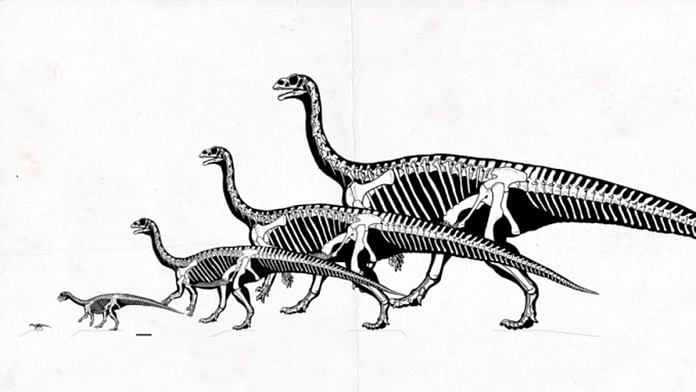Bengaluru: Paleontologists have unearthed the earliest evidence of dinosaurs living in herds and socialising by age groups at a site in Argentina, South America. The discovery of more than 100 fossilised eggs and skeletons of 80 individual dinosaurs, ranging from embryos to fully grown adults, within trenches dug by the animals themselves show clustering in socially cohesive groups by age and resting behaviour.
While it is known that some species of dinosaurs moved in herds, the behaviour is thought to have started to occur only about 150 million years ago. But the new fossils, belonging to the herbivore Mussaurus patagonicus, date back to 193 million years ago, indicating that herding behaviour was apparent in the animals much earlier than thought.
The reptilian, non-avian descendants of dinosaurs today do not travel or live in herds, but the avian descendants, i.e. birds, do gather in social groups. The researchers conclude that social age groupings like these would have lasted across the entire lifespan of individuals, and herding behaviour is what enabled some of these species to survive large extinction events and become dominant in terrestrial ecosystems.
The findings were published in the journal Scientific Reports this week.
Patagonian fossils
The fossils were discovered in the Laguna Colorada Formation, in the Santa Cruz Province of Argentina. The site is rich in dinosaur fossils and has been the source for many discoveries, including the discovery of the species M. patagonicus. The site covered an area of approximately one square kilometre.
In addition to the 11 individuals belonging to this species that were discovered earlier, the new expedition provided 69 new specimens with skeletons of individuals of various ages. There were eight small individuals, described as newborn as they are just bigger than the size of the embryos inside unhatched eggs. As they were all similarly sized, scientists think they hatched at the same time.
11 juvenile skeletons were found, about 50 m away from the hatchlings. These skeletons are all separated or are intertwined, indicating that they were all buried rapidly and simultaneously when they were physically close to each other. Nine young adults were discovered, who aged between one year and adults (15 years of age). Some had attained sexual maturity. Two more fully formed adults were also discovered close to each other.
The team also discovered over 100 eggs, some of which have preserved embryonic material. These eggs were found in structures that resembled nests, and paleontologists think the spacing of the nests indicates that it was a breeding ground rather than a colony. The eggs were laid in two or three layers, within trenches which the dinosaurs dug to make nests.
From the discovery of so many individuals of various ages together in a geographic location, paleontologists concluded that the species moved in herds and made social connections that lasted lifelong. The clustering of specimens by age shows that individuals were also segregated by age.
How dinosaurs became dominant
Very soon after dinosaurs started to first appear in the fossil record during the Triassic period, between 243 and 233 million years ago, they started to diversify. Today, over 900 genera and over 1000 species of terrestrial, non avian dinosaurs have been described. They became the dominant terrestrial vertebrates after the Triassic-Jurassic extinction event, which occurred 201 million years ago.
By the end of the Triassic period, herbivorous dinosaurs reached mega-sizes, with elongated necks and large muscular tails. These large-bodied, long-necked herbivores are called sauropodomorphs, and they were the most abundant four-legged terrestrial animals. The Triassic-Jurassic extinction event did not substantially affect their numbers or diversity, as evidenced by fossil records.
The new findings confirm that these dinosaurs were social herders and were gregarious.
Gregariousness is the tendency for animals to associate in social groups to form a stronger survival response. It can induce varying levels of physiological changes that can make animals act in a synchronous manner, especially when seasonal, such as flocking to a common mating ground, foraging large distances during certain times of the year, or taking to the skies together.
Paleontologists now theorise that one of the reasons these sauropodomorphs were able to maintain their numbers and their diversity through the Triassic-Jurassic extinction event is because of social herding behaviour and gregariousness.
The findings add more fuel to the increasing number of discoveries that are reshaping how we understand dinosaurs, especially how they seem to be less reptilian and more bird-like in behaviour and appearance.
(Edited by Paramita Ghosh)



